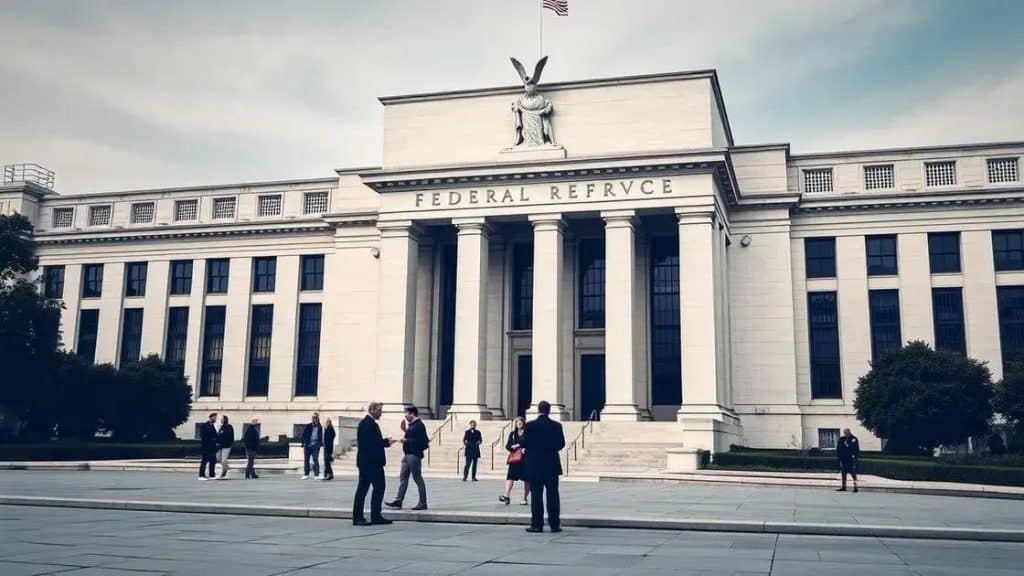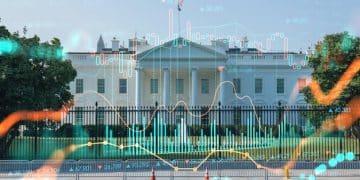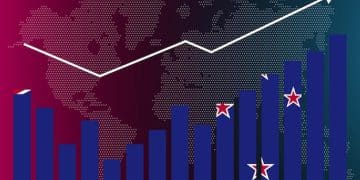Federal Reserve interest rates: what you need to know

Federal Reserve interest rates directly influence consumer borrowing costs, spending behavior, and overall economic growth, making their monitoring essential for financial decision-making.
Federal Reserve interest rates play a vital role in shaping the economy. Have you ever wondered how these rates impact your daily expenses or savings? This article dives into these significant considerations.
Understanding the role of the Federal Reserve
Understanding the role of the Federal Reserve is essential for grasping how our economy operates. This central banking system influences various aspects of economic life through its decisions on interest rates and monetary policy.
The Federal Reserve, often referred to as the Fed, is responsible for managing the nation’s money supply. By adjusting interest rates, the Fed aims to promote maximum employment, stabilize prices, and moderate long-term interest rates. Each of these goals is crucial for maintaining a healthy economy.
Key Functions of the Federal Reserve
One primary function of the Fed is to manage inflation. Keeping inflation in check ensures that the purchasing power of the dollar remains stable. This is achieved through careful monitoring and active management of interest rates.
- The Fed can increase interest rates to control rising inflation.
- Lowering rates can stimulate borrowing and spending, helping to boost economic growth.
- These adjustments directly affect loans, mortgages, and credit card rates for consumers.
- The Fed also plays a vital role in supervising and regulating banks, ensuring the safety and soundness of the financial system.
Another important aspect of the Federal Reserve’s role is conducting monetary policy. This involves open market operations, which are the buying and selling of government securities. These actions influence the availability of money and credit in the economy.
The Fed uses measures like the federal funds rate as a tool to communicate its monetary policy stance. This rate impacts the interest rates banks charge each other for short-term loans. A lower federal funds rate typically encourages economic activity, while a higher rate can have the opposite effect.
The Impact of Federal Reserve Actions
The decisions made by the Federal Reserve have a far-reaching impact. For instance, when the Fed raises interest rates, it can lead to higher borrowing costs for consumers and businesses alike. This often results in reduced spending, which can slow down economic growth.
Conversely, lowering rates can stimulate economic activity by making it cheaper to borrow money. This leads to increased spending, which helps boost the economy during downturns.
Ultimately, understanding the role of the Federal Reserve empowers individuals to make informed financial decisions. Whether considering taking out a loan or investing, being aware of the Fed’s influence is invaluable.
How interest rates influence economic growth

Interest rates play a crucial role in shaping economic growth. By adjusting these rates, the Federal Reserve can influence borrowing, spending, and investment across the economy. When interest rates are low, it becomes easier for consumers and businesses to borrow money. This often leads to increased spending on goods and services.
On the other hand, when the Fed raises interest rates, borrowing costs climb. This change can cool down economic activity because loans for homes, cars, and business expansions become more expensive. In this way, interest rates directly affect consumer behavior and business investment decisions.
The Connection Between Interest Rates and Spending
Lower interest rates typically result in more disposable income for households. With cheaper loans, people are more likely to finance new homes and cars, stimulating various sectors of the economy. This increased demand can lead to job creation and economic expansion.
- Consumers can save on interest payments, allowing for more spending on other goods.
- Businesses may invest in expansion projects due to lower financing costs.
- Increased consumer confidence often accompanies lower rates.
- A vibrant consumer market can drive overall economic growth.
Conversely, high interest rates can deter spending. For instance, if the Fed raises rates, people might hold off on purchasing big-ticket items. This hesitation can slow down production and result in less hiring, which may hinder economic growth.
Interest rates also impact investment strategies. Investors often shift their focus based on rate changes. In times of low rates, many prefer to invest in stocks and real estate, seeking higher returns. However, as rates rise, fixed-income investments like bonds can become more appealing.
Long-Term Economic Implications
The implications of changing interest rates extend beyond immediate spending. Over time, consistent rate hikes may lead to an economic slowdown, as businesses cut back due to higher financing costs. This, in turn, can result in higher unemployment rates.
Understanding how interest rates influence economic growth is essential for consumers, businesses, and policymakers. By analyzing these trends, individuals and organizations can make more informed financial decisions, positioning themselves for success.
The impact of rate changes on consumers
The impact of rate changes on consumers is significant and can shape their financial decisions. When the Federal Reserve adjusts interest rates, the effects ripple through the economy, influencing everything from loan rates to savings accounts.
For example, if the Fed raises interest rates, borrowing money becomes more expensive. This means higher monthly payments for mortgages, car loans, and credit cards. Consequently, consumers may choose to hold off on making large purchases or decide to reduce their spending.
Effects of Higher Interest Rates
Higher interest rates can lead to several critical effects on consumers:
- Increased Loan Payments: As interest rates rise, consumers see their monthly payments increase, leading to less disposable income.
- Decreased Borrowing: People may hesitate to take out loans for homes or cars, which slows down major purchases.
- Impact on Credit Cards: Higher rates can make carrying a balance on credit cards costlier, prompting consumers to pay off debts more quickly.
- Saving Incentives: On a positive note, higher rates can lead to better returns on savings accounts, encouraging people to save more.
While higher rates present challenges, lower interest rates provide a different set of benefits for consumers. When rates decrease, borrowing becomes cheaper, allowing individuals to take advantage of better loan terms.
Benefits of Lower Interest Rates
Consumers often experience several advantages resulting from lower interest rates:
- Affordable Loans: With lower rates, loans are easier to manage, allowing for larger purchases.
- Increased Spending: People are more likely to spend money on goods and services when they can borrow at lower rates.
- Investment Opportunities: Lower rates can encourage consumers to invest in businesses or purchase homes.
- Boost in Economic Activity: The overall economy often benefits from increased consumer spending during periods of low-interest rates.
Both rising and falling interest rates play a crucial role in shaping the financial landscape for consumers. The decisions made by the Federal Reserve are vital, and understanding their outcomes can help individuals navigate their financial future effectively.
Future trends in Federal Reserve interest rates

Understanding future trends in Federal Reserve interest rates is crucial for consumers, investors, and businesses. As the economy evolves, the Fed’s monetary policy adjusts to address various economic challenges. Predicting interest rate movements can help individuals make better financial decisions.
Currently, many analysts are observing inflation rates closely. If inflation remains high, the Fed may take action by increasing interest rates. Higher rates are typically employed to cool off an overheating economy and can lead to tighter financial conditions.
Potential Impacts of Rate Increases
When the Fed raises interest rates, several impacts can be expected:
- Slower Economic Growth: Higher borrowing costs can reduce consumer spending, leading to a slowdown in various sectors.
- Mortgage Rates Rise: As rates increase, the costs of mortgages will also rise, making home buying less affordable.
- Market Volatility: The stock market may experience increased volatility as investors adjust their expectations based on rate changes.
- Higher Savings Returns: Consumers may benefit from higher returns on savings accounts and fixed deposits.
On the other hand, if economic conditions improve or inflation decreases, the Fed may consider lowering interest rates. This action can have a stimulating effect on the economy.
Benefits of Rate Cuts
Lower interest rates can encourage economic activity. Consumers and businesses may see benefits that include:
- Increased Borrowing: Cheaper loans can lead to heavy borrowing for homes, cars, and business investments.
- Consumer Confidence: With lower rates and affordable loans, consumers may feel more confident in their purchasing power.
- Boosting Business Expansion: Companies can invest in growth when financing is less expensive.
- Economic Uplift: A thriving consumer market can result from increased spending, contributing to overall economic improvement.
Looking ahead, monitoring economic indicators will be essential for predicting the Federal Reserve’s interest rate decisions. Understanding these trends will empower individuals and businesses to make informed financial choices.
In conclusion, understanding the Federal Reserve interest rates is vital for navigating the financial landscape. These rates affect consumers and the economy through borrowing costs and spending choices. By keeping an eye on potential rate changes, individuals and businesses can make informed decisions that align with their financial goals. As we look to the future, being aware of these trends will help everyone prepare for upcoming economic shifts.
FAQ – Questions about Federal Reserve Interest Rates
What are Federal Reserve interest rates?
Federal Reserve interest rates are the rates at which banks lend to each other, influencing borrowing costs and economic activity.
How do interest rates affect consumers?
Interest rates affect consumers by determining the cost of loans, mortgages, and credit cards, influencing spending and saving behavior.
What happens when the Fed raises interest rates?
When the Fed raises interest rates, borrowing becomes more expensive, which can slow down economic growth and reduce consumer spending.
Why are future trends in interest rates important?
Future trends in interest rates are important as they help consumers and businesses anticipate changes in borrowing costs and make informed financial decisions.





